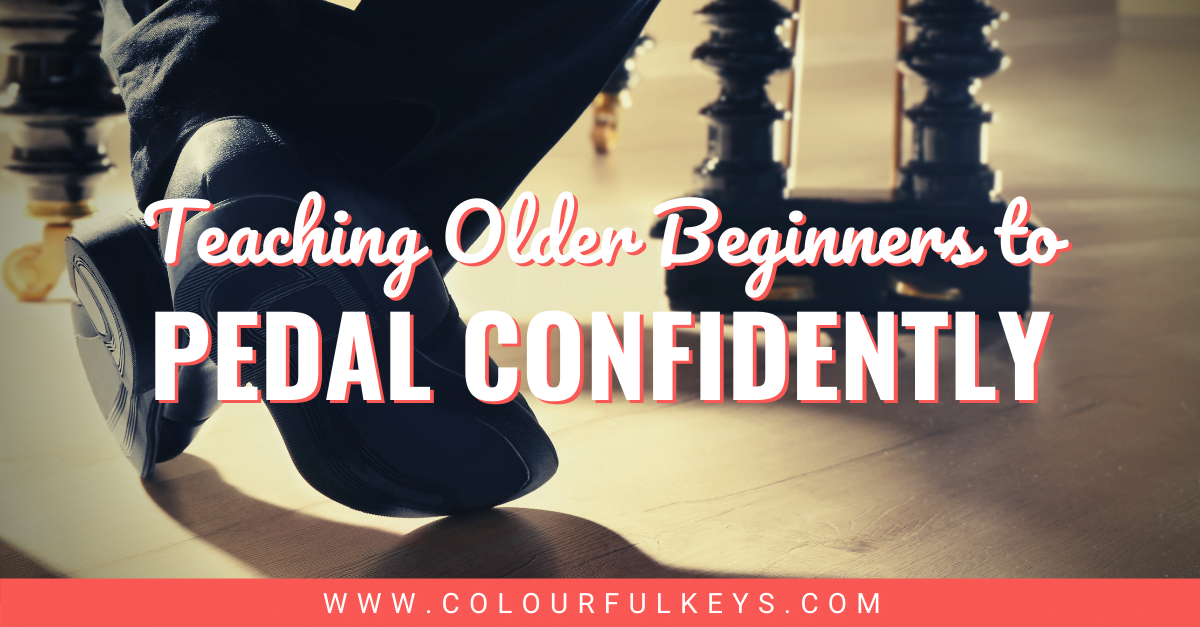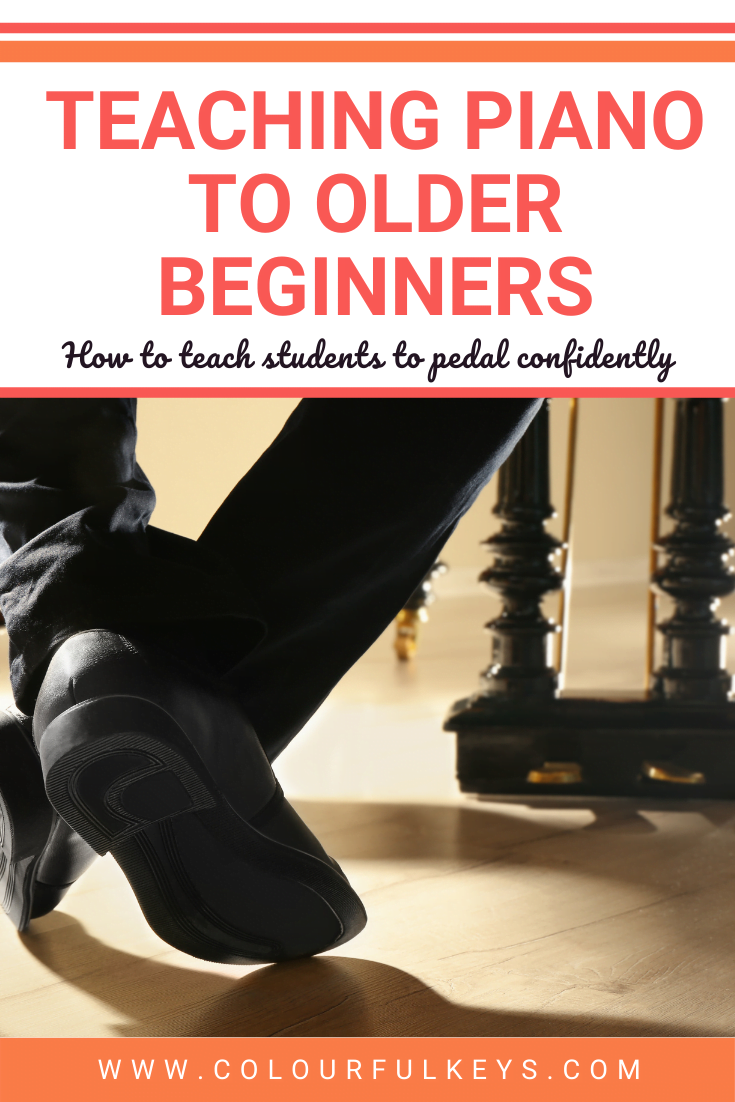Do you remember your first introduction to the pedal? I remember mine. To be precise, I remember not being introduced to it. When I switched teachers at about age 11, my new teacher assumed I’d already been taught how to pedal. I hadn’t, and I was too embarrassed to correct her.

I gradually figured it out through trial and error, but I think it would’ve been better to have learnt to pedal much sooner. My piano pedalling skills weren’t solid until I was 16 or 17. That’s 5-odd years of bashing away at the pedal any which way until I got a handle on it.
The pedal and I are best friends these days. I want all my older beginner piano students to experience that friendship early on in their piano journeys.

This post was originally published in July 2016, then updated in September 2021.
Trialling a New Approach to Teach Piano Pedalling
A few years ago, I decided to try an experiment to change the way I had been teaching older beginner piano students to pedal. I wanted to achieve two things with this experiment:
- Make pedalling less scary by introducing it right away.
- Make chords a core part of lessons and not an addition.
Once I had my objectives, I needed test subjects. Luckily I had two new older beginners who fit the bill perfectly: a new adult student and a 10-year-old beginner.
Let’s see if I managed to get these older beginners pedalling confidently in their first 6 weeks of piano lessons.
Step 1: Four Chords
I introduced both students to this four chord pattern in C major at their first lesson. Then I had them play the chord progression with just the tonic in the left hand and the chord in the right hand.

This is something I love doing because it sounds rich and full which is great for an older beginner’s ego. I often have new students add pedal to this right away, so I did for these two students too.
At this stage, though, I didn’t worry about legato pedalling. If I wanted to get these older beginner piano students pedalling confidently, I couldn’t throw them in at the deep end. My focus here was on pedalling basics:
- Heel on the ground
- Never taking their foot completely off the pedal
- Getting everything working together while keeping a steady beat
So we did it just like this to start:

So far, nothing was all that different from the way I normally do things. My two guinea pigs had learnt a C major chord progression in their first lesson and added pedal to make them sound great.
The difference was that this time, I didn’t stop there.
Step 2: Big Small
I normally save the full explanation of chords until we get to our first lead sheets, but for these two students it was at the second lesson. I explained the big-small way to find any major or minor chord. Then I had them practise finding all the major chords at home that week.
Obviously the 2 students couldn’t find all the chords instantly in their second week of lessons, but they both got used to figuring out any chord they needed. Plus they got comfortable with tones & semitones (whole & half steps) in the process.
These visual chord pattern grids are a handy resource to use when teaching major chords to adult piano students. Enter your email below to get yours free.

Subscribe to the newsletter and get the Visual Chord Pattern Grids
Enter your details to subscribe to the newsletter for piano teachers with information, tips and offers.
I hate spam as much as you do! I will only send you emails related directly to piano teaching and you can unsubscribe at any time.
Vibrant Music Teaching members can grab the full major and minor chord grids instantly from the VMT Library.
Not a member? Check out the membership – you don’t know what you’re missing!
Step 3: Key Signatures
The next step was to start finding those four chords in other key signatures. Over the next few weeks we started making our way around the circle of fifths playing the I-vi-IV-V progression in each key.
It was really fantastic to see these new beginners moving around the piano as much as they were at this stage. Anything which accelerates comfort with the keys (especially for a nervous older beginner) is time well spent, in my book.
Step 4: Legato Pedalling
As my two guinea pigs grew accustomed to finding the chords in each key, I started to refine their piano pedal technique.

Way back when I first started teaching, I used to tell piano students to clear the pedal simultaneously to the new note being played. This always resulted in the pedal being changed too early.
Every time.
Then someone on Facebook mentioned they always tell new students to change the pedal after the note is played – and then over time, they gradually move the pedalling back to where it should be.
Phew, that’s easier!
So with my 2 older beginner guinea pigs, I worked with them on changing the pedal just after they played the new tonic in their left hand.
Find more technique insights in the Technique section of our Planning Lessons hub page.
A Fruitful Introduction
My little experiment was a rousing success! Both of these older beginner students were pedalling confidently in their first few weeks of piano lessons. I didn’t hear groans or see anxious faces like I had with other beginners when I mentioned the “p” word.

By the time these 2 students were in their eighth week of lessons with me, they were more than happy to add the pedal to any piece or exercise I asked them to.
Lo and behold, the pedal had become their best friend, too.
How do you first teach piano pedalling?
Do you wait for until it comes up in the method book you’re using? Does it look different for different-aged students? Do you do something different with each and every student?
I’d love to hear in the comments below any tips you have for teaching older piano students to pedal.

Thank you for these ideas. I love them! Especially the idea of finding the various triads in many different keys early in the course of study. I feel very deeply that piano pupils must become comfortable and familiar with the different topography under their fingers in different keys as early as possible. I’m excited to have this additional tool in my toolbox to help this happen for them! I’ve been introducing the study of scales pretty early-on for them, but with the way that you introduce chords (without them necessarily having to know key signatures, etc.), this will introduce this to them even earlier!
Great job! And yes, pedaling should be also taught as early as possible, and this is a great way to do it. I use piano method books which introduce the pedal pretty early, a fact which delights me – but still not as early as you do! I will try this with my next beginner! The only possible impediment that I could see is that some younger beginners don’t yet have the dexterity in their fingers to be able to confidently play a 3-note triad with one hand. So, they might need to wait for a little more time before they can do this exercise. But I imagine that for these children, they could always play just a major 3rd (2 notes, only) instead of a triad, and still be able to benefit from this exercise and learn to use the pedal! Then, the triads could come later when the hand is ready for them.
Thank you for sharing this golden tip with us!
Hi Cherwyn, glad you found the idea useful. It would definitely be more difficult for the younger kids, as the dexterity is not there yet to do the triads. You might try just using open fifths or thirds as you say though for them if you want to teach the pedalling that way.
If you do try it out, make sure to report back! I’d love to hear how you get on with it!
I love your ideas and tips. Teaching them to play that first beat then up/down. I’ll try that.
I recently read the “naked piano” post and chuckled at the phrasing. 🙂
That’s usually what I show during the pedal introduction – what is happening inside when they play and when the pedal is added.
Absolutely. Great to make the connection with what is actually happening on the inside. 🙂
Thanks Nicola! Always something to get the juices flowing!